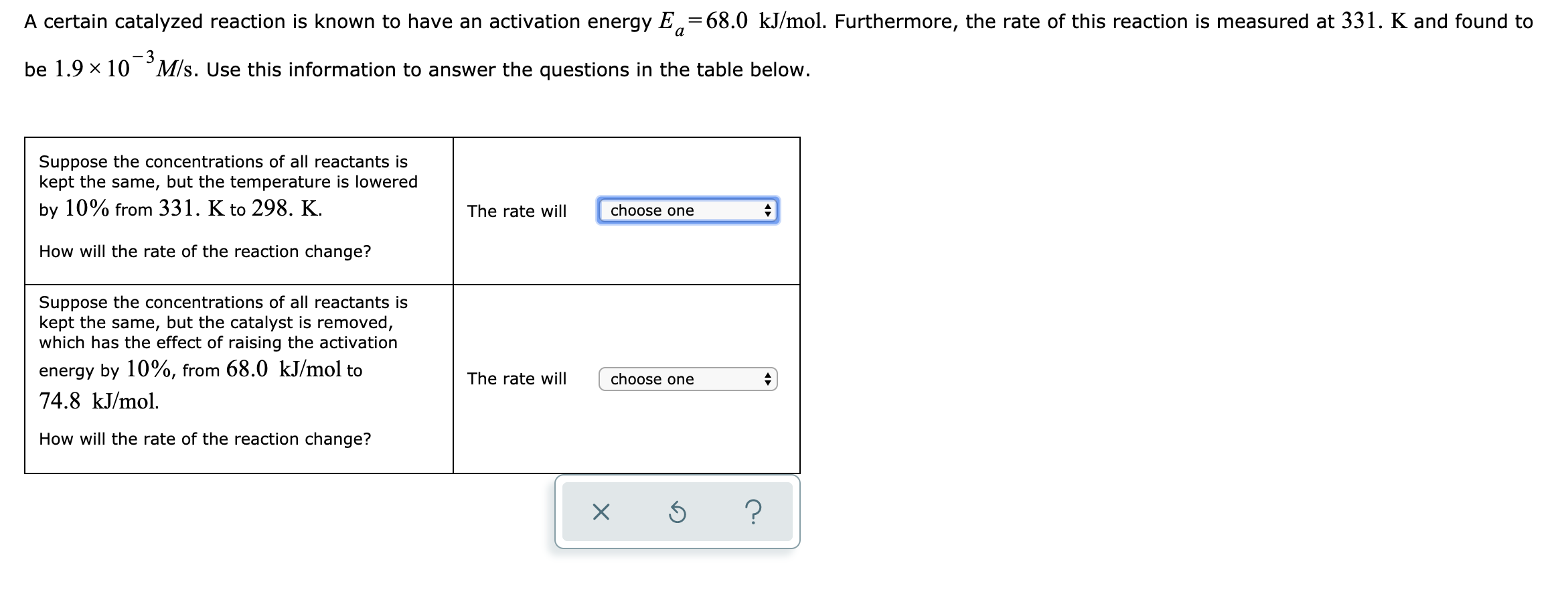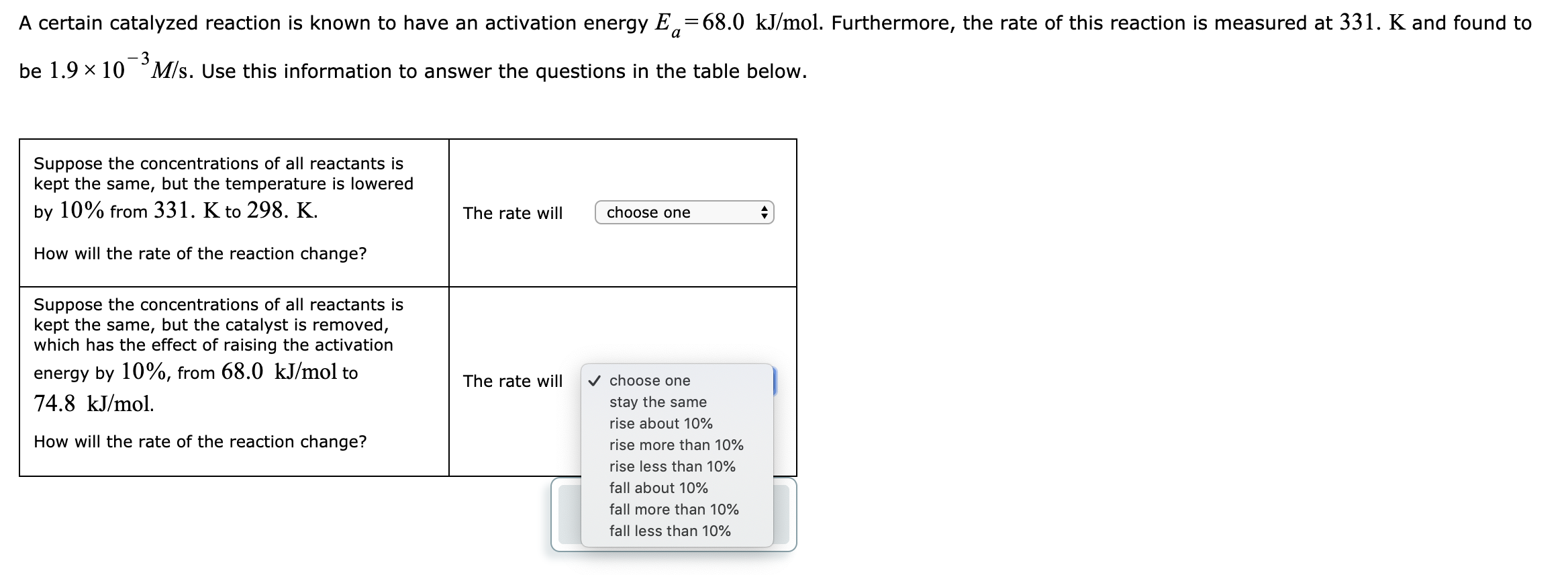A certain catalyzed reaction is known to have an activation energy E,=68.0 kJ/mol. Furthermore, the rate of this reaction is measured at 331. K and found to a be 1.9 x 10 ° M/s. Use this information to answer the questions in the table below. Suppose the concentrations of all reactants is kept the same, but the temperature is lowered by 10% from 331. K to 298. K. The rate will choose one How will the rate of the reaction change? Suppose the concentrations of all reactants is kept the same, but the catalyst is removed, which has the effect of raising the activation energy by 10%, from 68.0 kJ/mol to 74.8 kJ/mol. The rate will choose one How will the rate of the reaction change? A certain catalyzed reaction is known to have an activation energy E,=68.0 kJ/mol. Furthermore, the rate of this reaction is measured at 331. K and found to a - 3 be 1.9 x 10 °M/s. Use this information to answer the questions in the table below. Suppose the concentrations of all reactants is kept the same, but the temperature is lowered by 10% from 331. K to 298. K. The rate will choose one How will the rate of the reaction change? Suppose the concentrations of all reactants is kept the same, but the catalyst is removed, which has the effect of raising the activation energy by 10%, from 68.0 kJ/mol to 74.8 kJ/mol. The rate will v choose one stay the same rise about 10% How will the rate of the reaction change? rise more than 10% rise less than 10% fall about 10% fall more than 10% fall less than 10%
A certain catalyzed reaction is known to have an activation energy E,=68.0 kJ/mol. Furthermore, the rate of this reaction is measured at 331. K and found to a be 1.9 x 10 ° M/s. Use this information to answer the questions in the table below. Suppose the concentrations of all reactants is kept the same, but the temperature is lowered by 10% from 331. K to 298. K. The rate will choose one How will the rate of the reaction change? Suppose the concentrations of all reactants is kept the same, but the catalyst is removed, which has the effect of raising the activation energy by 10%, from 68.0 kJ/mol to 74.8 kJ/mol. The rate will choose one How will the rate of the reaction change? A certain catalyzed reaction is known to have an activation energy E,=68.0 kJ/mol. Furthermore, the rate of this reaction is measured at 331. K and found to a - 3 be 1.9 x 10 °M/s. Use this information to answer the questions in the table below. Suppose the concentrations of all reactants is kept the same, but the temperature is lowered by 10% from 331. K to 298. K. The rate will choose one How will the rate of the reaction change? Suppose the concentrations of all reactants is kept the same, but the catalyst is removed, which has the effect of raising the activation energy by 10%, from 68.0 kJ/mol to 74.8 kJ/mol. The rate will v choose one stay the same rise about 10% How will the rate of the reaction change? rise more than 10% rise less than 10% fall about 10% fall more than 10% fall less than 10%
Chemistry: Principles and Reactions
8th Edition
ISBN:9781305079373
Author:William L. Masterton, Cecile N. Hurley
Publisher:William L. Masterton, Cecile N. Hurley
Chapter11: Rate Of Reaction
Section: Chapter Questions
Problem 28QAP: Diethylhydrazine reacts with iodine according to the following equation: Â...
Related questions
Question

Transcribed Image Text:A certain catalyzed reaction is known to have an activation energy E,=68.0 kJ/mol. Furthermore, the rate of this reaction is measured at 331. K and found to
a
be 1.9 x 10 ° M/s. Use this information to answer the questions in the table below.
Suppose the concentrations of all reactants is
kept the same, but the temperature is lowered
by 10% from 331. K to 298. K.
The rate will
choose one
How will the rate of the reaction change?
Suppose the concentrations of all reactants is
kept the same, but the catalyst is removed,
which has the effect of raising the activation
energy by 10%, from 68.0 kJ/mol to
74.8 kJ/mol.
The rate will
choose one
How will the rate of the reaction change?

Transcribed Image Text:A certain catalyzed reaction is known to have an activation energy E,=68.0 kJ/mol. Furthermore, the rate of this reaction is measured at 331. K and found to
a
- 3
be 1.9 x 10 °M/s. Use this information to answer the questions in the table below.
Suppose the concentrations of all reactants is
kept the same, but the temperature is lowered
by 10% from 331. K to 298. K.
The rate will
choose one
How will the rate of the reaction change?
Suppose the concentrations of all reactants is
kept the same, but the catalyst is removed,
which has the effect of raising the activation
energy by 10%, from 68.0 kJ/mol to
74.8 kJ/mol.
The rate will
v choose one
stay the same
rise about 10%
How will the rate of the reaction change?
rise more than 10%
rise less than 10%
fall about 10%
fall more than 10%
fall less than 10%
Expert Solution
This question has been solved!
Explore an expertly crafted, step-by-step solution for a thorough understanding of key concepts.
This is a popular solution!
Trending now
This is a popular solution!
Step by step
Solved in 4 steps with 15 images

Recommended textbooks for you

Chemistry: Principles and Reactions
Chemistry
ISBN:
9781305079373
Author:
William L. Masterton, Cecile N. Hurley
Publisher:
Cengage Learning

Introductory Chemistry: A Foundation
Chemistry
ISBN:
9781337399425
Author:
Steven S. Zumdahl, Donald J. DeCoste
Publisher:
Cengage Learning

Chemistry for Engineering Students
Chemistry
ISBN:
9781337398909
Author:
Lawrence S. Brown, Tom Holme
Publisher:
Cengage Learning

Chemistry: Principles and Reactions
Chemistry
ISBN:
9781305079373
Author:
William L. Masterton, Cecile N. Hurley
Publisher:
Cengage Learning

Introductory Chemistry: A Foundation
Chemistry
ISBN:
9781337399425
Author:
Steven S. Zumdahl, Donald J. DeCoste
Publisher:
Cengage Learning

Chemistry for Engineering Students
Chemistry
ISBN:
9781337398909
Author:
Lawrence S. Brown, Tom Holme
Publisher:
Cengage Learning

Chemistry by OpenStax (2015-05-04)
Chemistry
ISBN:
9781938168390
Author:
Klaus Theopold, Richard H Langley, Paul Flowers, William R. Robinson, Mark Blaser
Publisher:
OpenStax

Chemistry
Chemistry
ISBN:
9781305957404
Author:
Steven S. Zumdahl, Susan A. Zumdahl, Donald J. DeCoste
Publisher:
Cengage Learning
